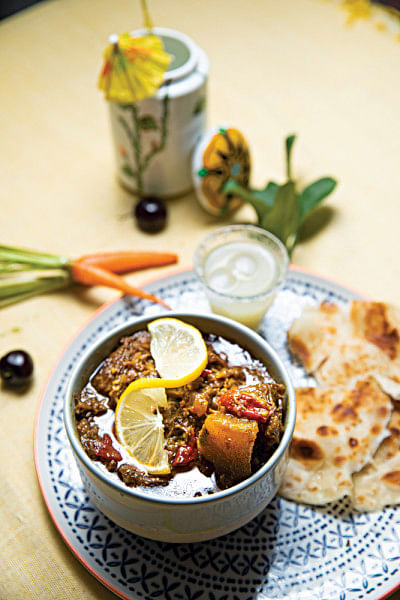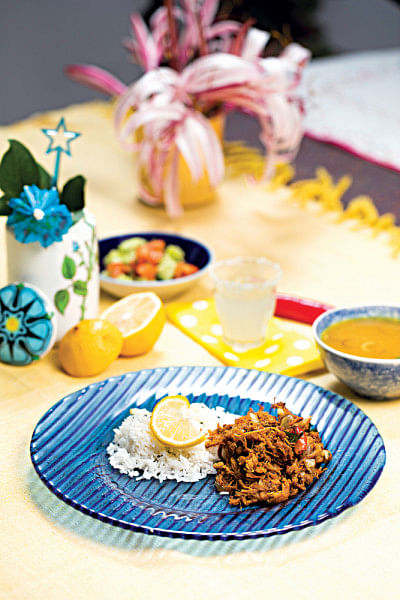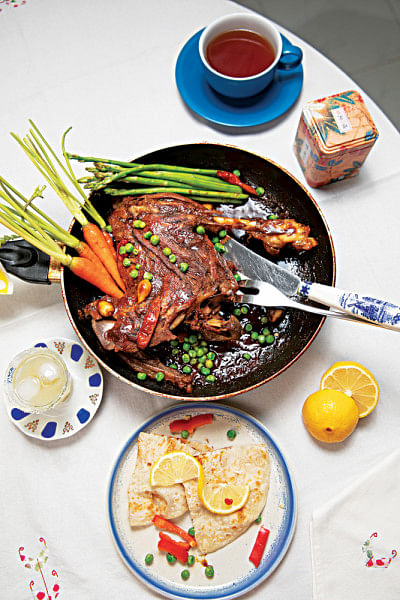Meat of the matter

Beef Curry
Eid day; the men, the women, and the children have all returned from Eid prayers. The butcher — amateur in all aspects — gets busy with his new found profession; he is the ubiquitous 'butcher for a day' on active service!
Now you may want to have the "rib eyes" separated the "sirloins" — well, not happening. This is beyond the butcher — in fact any butcher…even the professionals we see at the bazaars! If you do not mind getting your hands a little red, YouTube tutorials might come handy.
After the slaughter, the skins removed, and offals taken out, the legs are the first pieces of meat=bone to be separated.
Now, the meat and bones taken more often from the hind leg than the front, are chopped, mixed, and cleaned. The meat is now cooked in a large pot, mixed with the right amount of spices — which eventually gives the beef curry its ultimate kick. The entire preparation is time consuming, so a small portion of the meat is taken from the pot, and cooked to serve for lunch that is often shared with the butchers and their hands.
In some households, this is the first meal of Eid-ul-Azha, following one of the traditions of the Holy Prophet (PBUH). While it may result in an up-chuck reflex to many, some prefer the liver.
Just because what's cooking in the pots is your run-of-the-mill staple beef curry, does not necessary mean that things should be a mundane affair. Eid after all!
The way you treat cooked meat after, is what sets the plain Jane apart from the seasoned mistress of the house.
Served in a platter — the dish can be complemented with parathas; the garnishing can include lemon rinds, baby carrots, and a shot of lime juice — to cut the fat you are devouring.
Although most Eid traditions are now lost, and visiting family being near extinct, this simple 'beef curry' gives you the chance to entertain your guest with all the savouries and the desserts, and with the meat from the slaughter — just like the yesteryears.

JHURA MANGSHO
Sometime in the future…It's one of those days — too lazy to cook, yet the heart craves for something more, something special. Now imagine the worst case scenario; you have uninvited guests and the last time you did grocery shopping was more than a week ago.
For seasoned mistresses of the house, none are a source of any concern. In comes the refrigerated 'jhura mangsho' to the rescue. Although not 'beef jerky' as we know it, there is a time long culinary heritage of preserving meat, especially that from the slaughter of Eid-ul-Azha. Womenfolk would take elaborate measures to make 'meat shutki', but secrets to those recipes, perhaps, are now lost from our collective memory.
Yet, 'the jhura mangsho' remains tall, and more so when the meat is from the slaughter of Eid. Coming back to the seeming moment of crisis, all one needs to do is bring out one of the small boxes, out of many, and thaw it on a stove, over medium flame.
Now this is key — the beef gets tastier with every successive heating. And if you want the dish to retain its true nature, never use the microwave.
Every Bengali worth their salt appreciates steaming, thick musur daal, tempered to the exact level with garlic, and a dollop of ghee. Instead of plain rice, use polao chaal; nigella seeds for an added flavour.
For garnish, use sautéed split red/green chillies and onions, cut in quarters, to be added to the jhura mangsho for an extra oomph!
PS: Never underrate the humble lemon and the magic it can create, especially when teamed with daal. Keep ready a lazy shot of lukewarm lime juice to cut fat in a glass rimmed with salt.

SLOW COOKED MUTTON LEG ROAST
The days of festivity may have by now rolled onto day two, or even three; and your inner Mrs Dalloway is preparing for her annual post Eid dinner. You struggle, but manage to put a leash on your grandest ideas, and try to stick to the simpler alternatives. But one still needs to make an impression, because "Eat, Pray, Love" is now the universal motto.
The mutton leg is a familiar sight on any dinner spread, even of the slightest grandeur. And when it is Eid we are talking about, one finds it hard to imagine a formal occasion without it.
Mutton legs are not for the fainthearted, but there should not be any fear in attempting it, because there is no valid reason for distress.
Once again, the marinade is important — ginger/garlic paste, black peppercorn, lemon juice, salt. Make some slits onto the leg, and do be generous in applying the mixture. Refrigerate overnight.
The day after — take the leg out of the fridge 3-4 hours before you want to have the dish ready to serve. Make a mixture of pomegranate molasses; if you do not want pomegranate molasses, use our own spoonful of 'jhola gur.' Sprinkle black pepper, and lemon juice. Mix the marinade with the meat and set aside.
Now brush olive oil in a skewer large enough to accommodate the leg piece. Turn each side of the roast. Pour in the hot mixture over the piece to ensure that the meat is evenly cooked and the meat releases its juices..
Now, put in an oven for slow cooking. Three hours.
Note — This dish is best served with grilled red chilli, garlic cloves, green peas, asparagus, and baby carrots; if desired one can sauté them using olive oil before setting the platter.

Steak with mango salsa
Brisket, shank, round, shank — these are your safest bet for making steaks! If you have already mastered the fine art in butchery to the extent that you can go for the tenderer, juicier meat options, then great!
The secret in making a decent steak lies in the cut, true; but more so in selecting the right marinade. As difficult as it may appear at the beginning, this is no rocket science.
The first thing in your to-do list would be to get the meat pieces chopped in the right portions, and then pounded with a mallet. Then comes the marinade, which makes makes even the rough meat fibres tenderer.
One must tub the meat pieces with a generous amount of the marinade comprising of dried herbs, soy sauce, Worcestershire sauce, olive oil, lemon juice, and garlic. Go heavy on the lemon juice if you want the dish to be extra-tender.
While some cooks prefer to leave it for overnight refrigeration, a period of 2 to 3 hours is sufficient, and hence, perfect for serving for Eid day dinner. Once everything seems to be in order, you can put the meat pieces in an oven, grill over charcoal, or simply fry on skillet!
Eid feasts are all about indulgences, but there is a limit that none should transgress, especially those who are on a calorie count/or have their blood sugar out of control.
The post Eid struggle is not only to battle against the urge for an extra helping of meat, but that extravagant spoonful of carbs. So, replace carbs in all forms with simple sides like asparagus, and green peas. Mix with olive oil and toss them on a pan before serving.
If you want to go one step futher, use the ripe mangos that are now widely available; select crunchy bell peppers, zingy red onions, zesty cilantros, spicy jalapenos, and tangy lime for the perfect balance of the sweet heat – in minutes.
Few things in life are better than storming the senses with great steaks and mango salsa on the side.
Promise!

 For all latest news, follow The Daily Star's Google News channel.
For all latest news, follow The Daily Star's Google News channel. 



Comments